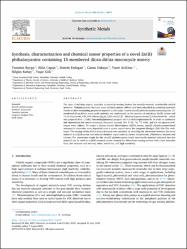Synthesis, characterization and chemical sensor properties of a novel Zn(II) phthalocyanine containing 15-membered dioxa-dithia macrocycle moiety

Göster/
Erişim
info:eu-repo/semantics/openAccessTarih
2021Yazar
Baygu, YaseminÇapan, Rifat
Erdoğan, Matem
Özkaya, Cansu
Açıkbaş, Yaser
Kabay, Nilgün
Gök, Yaşar
Üst veri
Tüm öğe kaydını gösterÖzet
The issue of utilizing organic materials in chemical sensing devices has recently received considerable critical attention. Phthalocyanines (Pcs) and metal phthalocyanines (MPcs) have been identified as promising materials thanks to their outstanding properties reported in this study. A novel zinc(II) phthalocyanine containing four 15membered dioxa-dithia macrocyclic moieties was synthesized via the reaction of anhydrous Zn(II) acetate and 13,14-dihydro-6H,12H,20H-tribenzo[f,j,n][1,5]dioxa[9,12] dithiacyclopenta-decine-2,3-dicarbonitrile which was prepared from 1,3-di(2-thio-methylphenoxy) propane and 4,5-dichloropthalonitrile. In order to synthesize and characterize this novel compound, elemental analysis, MS, FT-IR, 1H, 13C NMR, and UV-vis spectral techniques were utilized. To create a Quartz Crystal Microbalance (QCM) sensor, zinc(II) phthalocyanine-based macrocyclic molecules were deposited onto a quartz crystal using the Langmuir-Blodgett (LB) thin film technique. The sensing ability of this chemical sensor was examined by recording the interaction between this novel material as a QCM-sensor and selected chemical vapors such as carbon tetrachloride, chloroform, benzene and toluene. The interaction results for this zinc(II) phthalocyanine based macrocyclic material indicated that this material can be used as a QCM chemical sensor element for chloroform sensing devices with a low detection limit, fast response and recovery times, selectivity, and high sensitivity.

















